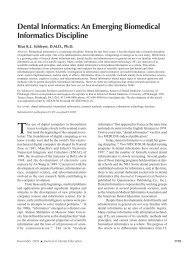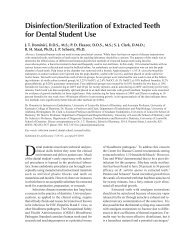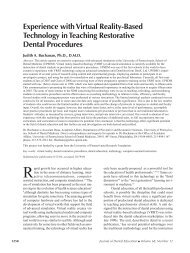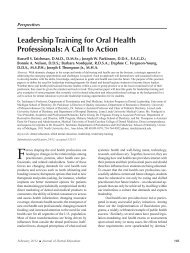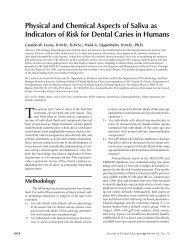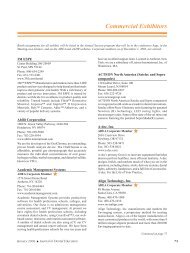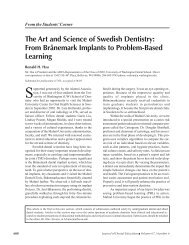A Survey of Local Anesthesia Education in Turkish Dental Schools
A Survey of Local Anesthesia Education in Turkish Dental Schools
A Survey of Local Anesthesia Education in Turkish Dental Schools
Create successful ePaper yourself
Turn your PDF publications into a flip-book with our unique Google optimized e-Paper software.
Results<br />
Of the seventeen dental schools contacted,<br />
eleven (64.7 percent) responded to the survey. No response<br />
was received from the rema<strong>in</strong><strong>in</strong>g six schools,<br />
even though notices were sent. The mean number <strong>of</strong><br />
dental students at the schools was 426±174 (between<br />
115 and 700 per school), show<strong>in</strong>g a wide variation;<br />
the mean <strong>of</strong> yearly enrollment <strong>of</strong> dental students<br />
was 100±38.<br />
All <strong>of</strong> the dental schools said they beg<strong>in</strong> the<br />
theoretical background <strong>of</strong> local anesthesia curricula<br />
dur<strong>in</strong>g the first half <strong>of</strong> the third year. On average,<br />
most dental schools beg<strong>in</strong> to teach the practical aspects<br />
dur<strong>in</strong>g the second half <strong>of</strong> the third year, after<br />
the theoretical background has been taught (Table<br />
1). Overall results <strong>of</strong> the survey on teach<strong>in</strong>g <strong>of</strong> local<br />
anesthesia <strong>in</strong> curricula <strong>of</strong> <strong>Turkish</strong> dental schools are<br />
shown <strong>in</strong> Table 2. Most dental schools use textbooks<br />
and syllabi. The theoretical aspects <strong>of</strong> LA education<br />
are assessed by either a written exam<strong>in</strong>ation only<br />
(100 percent) or both written and oral exam<strong>in</strong>ations<br />
(82 percent). Sixty percent <strong>of</strong> the dental schools have<br />
a practical exam<strong>in</strong>ation to evaluate the students’<br />
learn<strong>in</strong>g. In almost half <strong>of</strong> the schools, the students<br />
practiced on non-human objects (e.g., fruits such<br />
as oranges) before they started cl<strong>in</strong>ical practice on<br />
humans. N<strong>in</strong>ety-one percent <strong>of</strong> the surveyed schools<br />
reported be<strong>in</strong>g satisfied with their current local anesthesia<br />
education; only 10 percent were plann<strong>in</strong>g<br />
further changes <strong>in</strong>clud<strong>in</strong>g precl<strong>in</strong>ical tra<strong>in</strong><strong>in</strong>g models.<br />
Discussion<br />
Most practitioners recognize the importance<br />
<strong>of</strong> dental anesthesia education and tra<strong>in</strong><strong>in</strong>g. However,<br />
little consensus exists regard<strong>in</strong>g the extent <strong>of</strong><br />
anesthesia tra<strong>in</strong><strong>in</strong>g that is appropriate for a dental<br />
school’s undergraduate curriculum. This is the first<br />
study to assess theoretical and cl<strong>in</strong>ical tra<strong>in</strong><strong>in</strong>g <strong>in</strong><br />
local anesthesia <strong>in</strong> <strong>Turkish</strong> dental schools. Question-<br />
naires were sent to the heads <strong>of</strong> the Department <strong>of</strong><br />
Oral and Maxill<strong>of</strong>acial Surgery <strong>of</strong> seventeen schools.<br />
Completed questionnaires were returned by eleven<br />
schools, result<strong>in</strong>g <strong>in</strong> a response rate <strong>of</strong> 64.7 percent.<br />
The results show similarities as well as diversities.<br />
One <strong>of</strong> the similarities is that the theoretical<br />
<strong>in</strong>struction is separated from the practical <strong>in</strong>struction<br />
and precedes the cl<strong>in</strong>ical teach<strong>in</strong>g by half a year. One<br />
<strong>of</strong> the differences is <strong>in</strong> adm<strong>in</strong>ister<strong>in</strong>g local anesthetics<br />
on non-human objects prior to start<strong>in</strong>g work <strong>in</strong><br />
the cl<strong>in</strong>ics. At some dental schools, the students<br />
adm<strong>in</strong>istered LA on non-human objects such as an<br />
orange, while the other students performed their<br />
first <strong>in</strong>jection on a fellow dental student. In most<br />
cases (73 percent), dental students performed their<br />
first <strong>in</strong>jection on fellow dental students who do not<br />
require dental treatment, under the supervision <strong>of</strong><br />
an oral and maxill<strong>of</strong>acial surgeon. These results are<br />
consistent with the study conducted by Brand et al. 2<br />
and with older reports about local anesthesia teach<strong>in</strong>g<br />
<strong>in</strong> the United States. 4,8<br />
Electronic tra<strong>in</strong><strong>in</strong>g models have been available<br />
for more than twenty years. However, none <strong>of</strong><br />
the <strong>Turkish</strong> dental schools currently use electronic<br />
tra<strong>in</strong><strong>in</strong>g models before the <strong>in</strong>itial <strong>in</strong>jection on humans<br />
although several dental schools reported plans to <strong>in</strong>troduce<br />
them <strong>in</strong> the near future. Furthermore, there is<br />
no evidence that the electronic tra<strong>in</strong><strong>in</strong>g models have<br />
shown any superiority <strong>in</strong> the teach<strong>in</strong>g <strong>of</strong> local anesthesia.<br />
9 However, <strong>in</strong> the near future, the virtual reality<br />
method may also play an important role <strong>in</strong> tra<strong>in</strong><strong>in</strong>g<br />
students on local anesthesia with the accumulation<br />
<strong>of</strong> more data on its success. 10<br />
Brand et al. evaluated dental students’ op<strong>in</strong>ion<br />
<strong>of</strong> their LA education and reported that programs<br />
and rat<strong>in</strong>g <strong>of</strong> this teach<strong>in</strong>g by dental students show<br />
a wide variation across Europe. 9 However, students’<br />
op<strong>in</strong>ion was not considered <strong>in</strong> our study. It is evident<br />
that feedback from the recipients <strong>of</strong> education will<br />
provide useful <strong>in</strong>formation regard<strong>in</strong>g the best methodology<br />
to familiarize a novice with local anesthetic<br />
techniques.<br />
Table 1. Initial teach<strong>in</strong>g <strong>of</strong> local anesthesia <strong>in</strong> curricula <strong>of</strong> <strong>Turkish</strong> dental schools (n=11)<br />
Initial Teach<strong>in</strong>g Theoretical Background Practical Aspects<br />
Year 3, first half 11 (100%) —<br />
Year 3, second half — 10 (81%)<br />
Year 4, first half — 1 (9%)<br />
March 2013 ■ Journal <strong>of</strong> <strong>Dental</strong> <strong>Education</strong> 349



